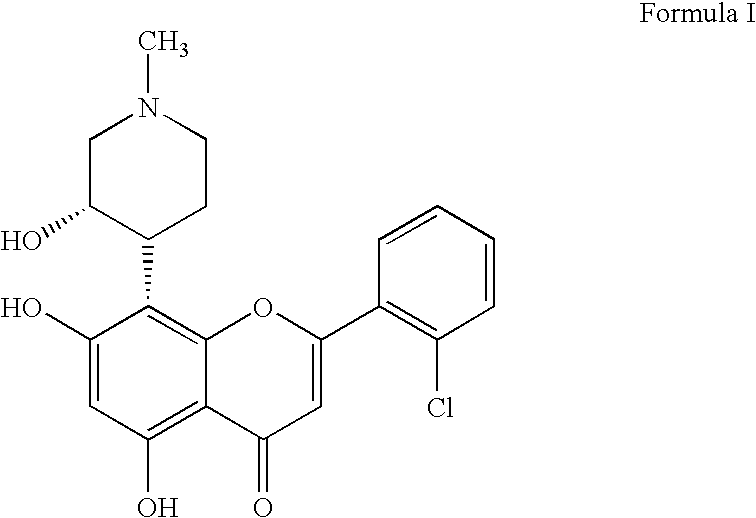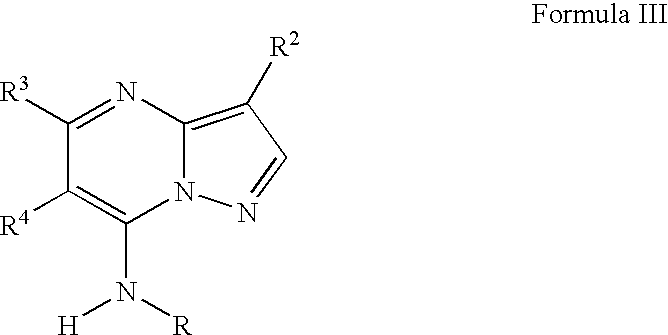Novel pyrazolopyrimidines as cyclin dependent kinase inhibitors
a cyclin dependent kinase inhibitor and pyrazolopyrimidine technology, applied in the field of pyrazolo1, 5apyrimidine compounds, can solve the problems of increased cdk2 activity and poor overall survival
- Summary
- Abstract
- Description
- Claims
- Application Information
AI Technical Summary
Benefits of technology
Problems solved by technology
Method used
Image
Examples
examples 2-4
Preparative Examples 2-4
[0185] By essentially the same procedure set forth in Preparative Example 1, only substituting the nitrile shown in Column 2 of Table 2, the compounds in Column 3 of Table 2 were prepared:
TABLE 2Prep.Ex.Column 2Column 3233.10
example 4
Preparative Example 4
[0186]
[0187] 2-Carbomethoxycyclopentanone (6.6 ml, 0.05 mol) in THF (15 ml) was added dropwise to a vigorously stirred suspension of NaH (60% in mineral oil, 4 g, 0.1 mol) in THF (100 ml) at 0-10° C. When bubbling ceased, the reaction mixture was treated at the same temperature with ClCOOMe (7.8 ml, 0.1 mol) in THF (15 ml). The resulted off-white suspension was stirred for 30 minutes at room temperature and 30 minutes under reflux. The reaction was monitored by TLC for disappearance of starting material. The reaction mixture was quenched with water carefully and partitioned between ethyl acetate and saturated solution of ammonium chloride in a funnel. Shaken and separated, the organic layer was washed with brine and dried over anhydrous sodium sulfate. Solvents were removed, and the residue was purified by flash chromatography, eluted with 5% and then 10% ethyl acetate in hexane. 9.4 g colorless oil was obtained with 94% yield. 1H NMR (CDCl3) δ 3.90(s, 3H), 3.73...
example 5
Preparative Example 5
[0188]
[0189] To lithium diisopropylamide solution in THF (2.0 N, 0.04 mol) at −65° C., was added dropwise 2,2-dicarbomethoxycyclopentanone (4 g, 0.02 mol) in THF (60 ml). The resulted reaction mixture was stirred at the same temperature before adding methyl chloroformate (1.54 ml, 0.02 mol). Reaction mixture stirred for an hour and poured into saturated ammonium chloride solution with some ice. This solution was extracted three times with ether, and the combined ethearal layers were dried over sodium sulfate. Solvents were removed in vacuo, and the residue was purified by flash chromatography, eluted with 30% increased to 50% ethyl acetate in hexane. 2.3 g yellowish oil was obtained with 58% yield. 1H NMR (CDCl3) δ 3.77(s, 6H), 3.32(t, 1H), 3.60-3.10(m, 4H).
PUM
| Property | Measurement | Unit |
|---|---|---|
| pharmaceutical composition | aaaaa | aaaaa |
Abstract
Description
Claims
Application Information
 Login to View More
Login to View More - R&D
- Intellectual Property
- Life Sciences
- Materials
- Tech Scout
- Unparalleled Data Quality
- Higher Quality Content
- 60% Fewer Hallucinations
Browse by: Latest US Patents, China's latest patents, Technical Efficacy Thesaurus, Application Domain, Technology Topic, Popular Technical Reports.
© 2025 PatSnap. All rights reserved.Legal|Privacy policy|Modern Slavery Act Transparency Statement|Sitemap|About US| Contact US: help@patsnap.com



